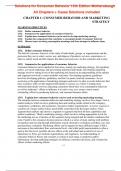Solutions for Consumer Behavior 15th Edition Mothersbaugh
All Chapters + Cases Solutions included
CHAPTER 1: CONSUMER BEHAVIOR AND MARKETING
STRATEGY
LEARNING OBJECTIVES
LO1: Define consumer behavior
LO2: Summarize the applications of consumer behavior
LO3: Explain how consumer behavior can be used to develop marketing strategy
LO4: Explain the components that constitute a conceptual model of consumer behavior
LO5: Discuss issues involving consumption meanings and firm attempts to influence them
SUMMARY
LO1: Define consumer behavior
The field of consumer behavior is the study of individuals, groups, or organizations and the
processes they use to select, secure, use, and dispose of products, services, experiences, or
ideas to satisfy needs and the impacts that these processes have on the consumer and society.
LO2: Summarize the applications of consumer behavior
Consumer behavior can be applied in four areas, namely (a) marketing strategy, (b) regulatory
policy, (c) social marketing, and (d) creating informed individuals. Developing marketing
strategy involves setting levels of the marketing mix based on an understanding of the market
and segments involved to create desirable outcomes. Developing regulatory guidelines
involves developing policies, guidelines, and laws to protect and aid consumers. Social
marketing is the application of marketing strategies and tactics to alter or create behaviors that
have a positive effect on the targeted individuals or society as a whole. Creating more
informed individuals involves educating consumers about their own consumption behaviors
as well as marketers’ efforts to influence it in such a way as to create a more sound
citizenship, effective purchasing behavior, and reasoned business ethics.
LO3: Explain how consumer behavior can be used to develop marketing strategy
The interplay between consumer behavior and marketing strategy involves five stages. First is
market analysis which involves gathering data and tracking trends related to the company,
competitors, conditions, and consumers. Second is market segmentation. A market segment is
a portion of a larger market whose needs differ somewhat from the larger market. Firms
segment their markets and choose a segment or segments that best fit their capabilities and
market conditions. Third is marketing strategy which involves setting appropriate levels for
the marketing mix as a function of the segments being targeted and the market conditions that
exist. Fourth is the consumer decision process which is a series of steps starting with problem
recognition and moving through information search, alternative evaluation, purchase, use, and
post purchase evaluation. Marketing efforts can be targeted to these different stages. Fifth is
outcomes at the individual, firm, and societal level. And while profit maximization is often a
goal at the firm level, possible adverse effects at the individual and societal level are of
importance to firms, government organizations, and regulators. An understanding of
consumer behavior theory and concepts is critical at each stage as marketers gather
information, develop marketing strategies to influence consumer decisions, and evaluate the
effects of their marketing efforts.
1-1
, LO4: Explain the components that constitute a conceptual model of consumer behavior
The conceptual model of consumer behavior developed here can be broken into four
interrelated parts. External and internal influences affect the consumer’s self-concept and
lifestyle which, in turn, affects the decision process. External influences (Part 2 of the text)
include culture, reference groups, demographics, and marketing activities. Internal influences
(Part 3) include perception, emotions, attitudes, and personality. Self-concept is the totality of
an individual’s thoughts and feelings about oneself. Lifestyle is, quite simply, how one lives,
including the products one buys, how one uses them, what one thinks about them, and how
one feels about them. External and internal factors operate to influence self-concept and
lifestyle which, in turn, influences the decision process (Part 4). Overlaying these basic
components is organizations (Part 5) and regulation (Part 6). Organizations or businesses can
also be consumers as when Mercedes-Benz purchases dashboard subcomponents from a
supplier. This type of marketing is often termed business-to-business (B2B) marketing to
differentiate it from business-to-consumer (B2C) marketing that is the focus of much of this
text. The special nature of organizations and how they behave warrants special attention.
Regulation is an aspect of consumer behavior that permeates marketer actions relating to all
parts of our model and it warrants special attention as well.
LO5: Discuss issues involving consumption meanings and firm attempts to influence
them
Consumption has meaning beyond the satisfaction of minimum or basic consumer needs.
Thus, consumers might purchase Nike sneakers not only to satisfy the functional needs
associated with safety and support but also for symbolic needs associated with status, identity,
and group acceptance. Some criticize marketers for their attempts to instill in, or amplify,
consumer desires for products beyond minimum functional aspects. And while this criticism
may hold true, it also seems likely that such desires and symbolic meanings are naturally
assigned to objects even in the relative absence of marketing. Nonetheless, the ethical
implications of marketers’ actions in this regard are important to consider.
1-2




